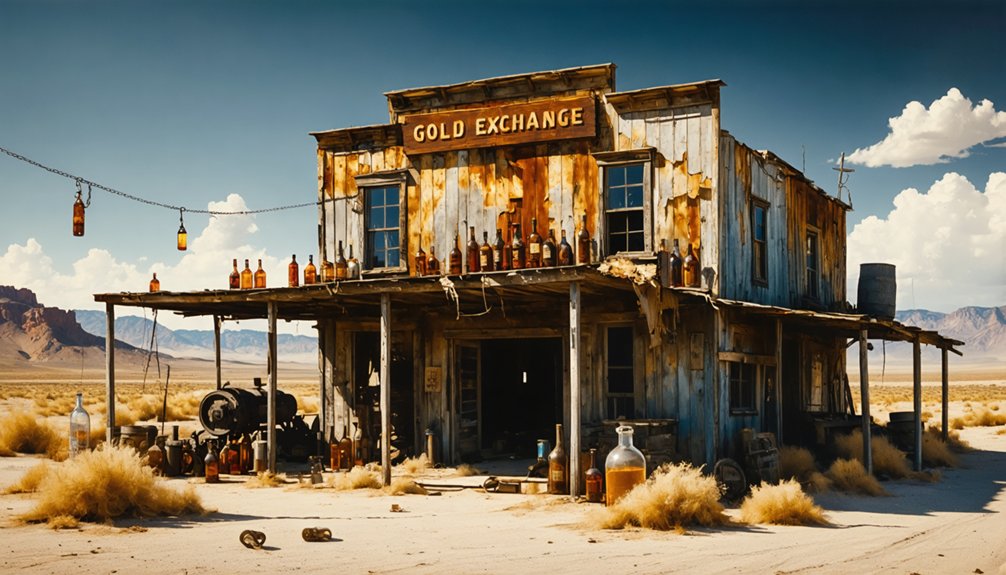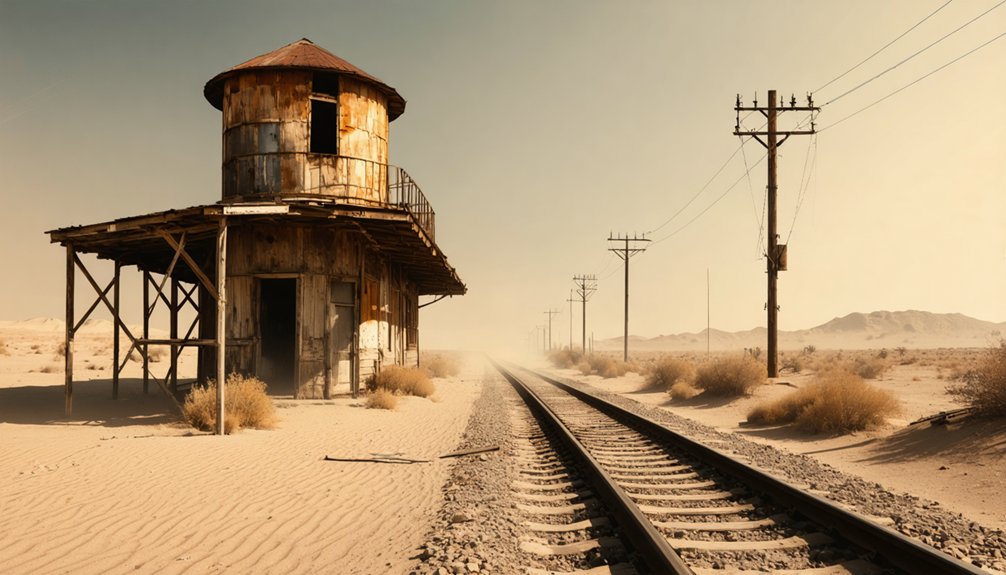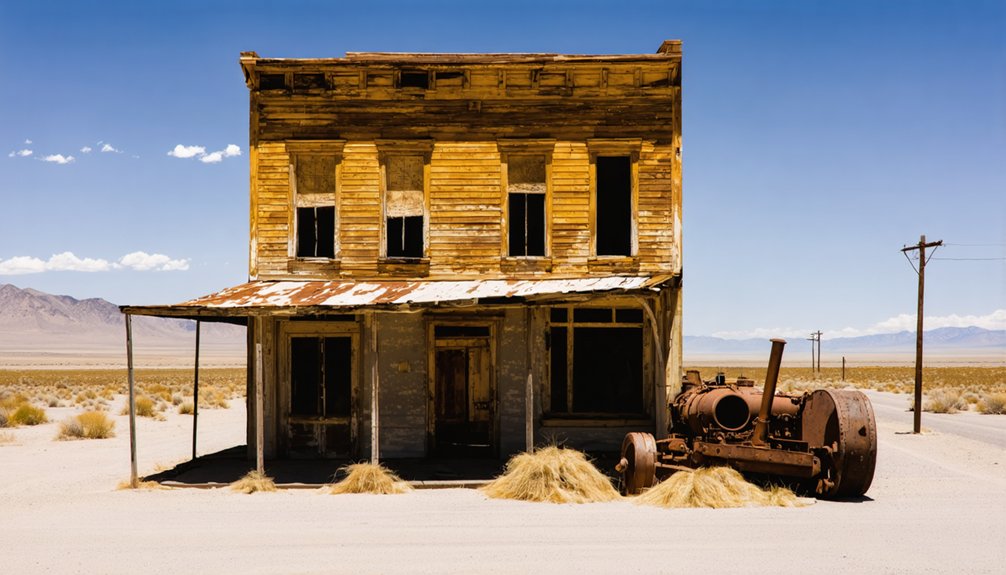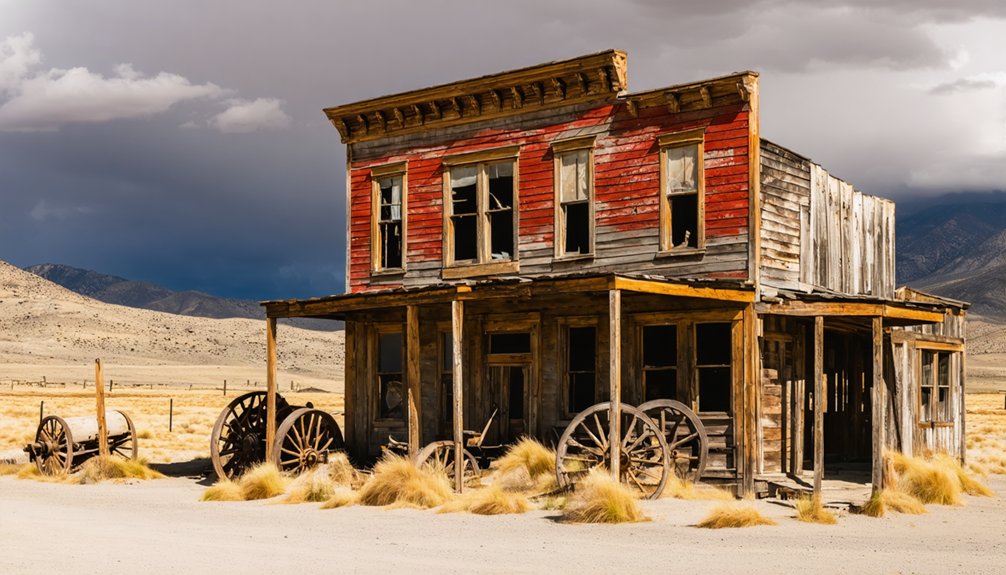You’ll find that boomtowns became ghost towns primarily due to their dependence on single resources or industries, making them vulnerable to market fluctuations and resource depletion. When commodity prices collapsed or resources were exhausted, these communities experienced rapid population exodus, infrastructure deterioration, and social service breakdowns. Environmental contamination and public safety concerns further accelerated their decline. The complex interplay of economic fragility, technological changes, and social instability reveals a deeper story of boom-and-bust cycles.
Key Takeaways
- Economic dependence on a single resource or industry made boomtowns vulnerable when that resource depleted or market prices collapsed.
- Mass population exodus occurred when jobs disappeared, leading to business closures and deterioration of public services.
- Environmental contamination from industrial activities created health hazards and costly cleanup challenges, making areas uninhabitable.
- Infrastructure and social services broke down due to reduced tax revenue and insufficient maintenance during economic decline.
- Technological advances made certain industries obsolete, eliminating the economic foundation that sustained these communities.
The Rise and Fall of Single-Resource Economies
While boomtowns initially flourish due to the discovery of valuable natural resources, their heavy dependence on a single economic driver ultimately sows the seeds of their downfall.
You’ll find that resource dependency creates inherent economic fragility, as these towns become vulnerable to market fluctuations and eventual resource depletion.
When prices drop or demand falls for their primary commodity, whether it’s gold, oil, or timber, the entire local economy suffers immediate impacts.
Without diversified industries to provide alternative opportunities, you’ll see how these communities struggle to maintain stability.
A single-industry economy leaves communities vulnerable, teetering on the edge when that sole economic pillar begins to crumble.
The inefficient allocation of resources often compounds these towns’ economic challenges.
Natural resources like water and air become severely degraded as uncontrolled exploitation continues unchecked.
The finite nature of many extracted resources fundamentally guarantees an eventual bust phase.
As reserves dwindle, businesses close, workers leave, and the once-thriving boomtown begins its transformation into a ghost town.
Population Exodus and Community Breakdown
When communities face severe economic downturns or environmental threats, you’ll witness mass departures that can drain a town’s population within months or even weeks.
As residents abandon their homes and businesses, you’ll find critical social services like schools, medical facilities, and emergency response becoming unsustainable due to lost tax revenue and declining demand.
Industrial cities like McKeesport saw their populations plummet after the collapse of steel devastated their economic foundation.
The exodus often erases generations of shared cultural heritage and community bonds, transforming once-vibrant social spaces into hollow reminders of former prosperity. This pattern is starkly illustrated in Russia’s Arctic region, where many settlements closed due to massive population losses following the Soviet era.
Rapid Mass Population Departures
Three primary factors drive rapid population departures from boomtowns: economic shocks, housing affordability crises, and demographic shifts.
When you examine outmigration trends, you’ll find that boomtowns heavily dependent on single industries face extreme economic vulnerability. Once commodity prices crash or resources deplete, these communities experience sudden mass departures as employment opportunities vanish. California has seen over 352,000 residents leave between April 2020 and January 2022.
You’ll notice this pattern intensifies when housing costs spiral upward, forcing middle-class residents to seek more affordable locations. Major metropolitan areas like San Francisco, New York experienced significant population losses due to high living costs.
The rise of remote work has accelerated this exodus, as you’re no longer bound to expensive urban cores.
These departures create a domino effect – as populations shrink, local businesses close, public services decline, and community institutions weaken, triggering even more residents to leave in search of stability elsewhere.
Social Services Break Down
As populations rapidly depart boomtowns, the social service infrastructure begins to crumble under mounting pressures.
You’ll witness the systematic collapse of healthcare facilities, educational institutions, and public welfare programs that once sustained community life. Local hospitals close their doors while remaining clinics struggle with reduced staffing and resources, leaving you with limited access to medical care. Major cities like San Francisco and Los Angeles see rising grocery costs straining essential services.
The domino effect of service scarcity extends beyond healthcare – your schools consolidate or shut down, emergency services decrease coverage, and social support networks disintegrate. Cities like Winston-Salem see their young graduates leaving for better opportunities, further straining local services.
This breakdown particularly impacts vulnerable residents, deepening social isolation as formal assistance programs contract. You’ll find public infrastructure deteriorating from neglect while housing instability rises, creating a self-reinforcing cycle of community decline that accelerates the exodus of remaining residents.
Lost Community Identity
The disintegration of community identity strikes at the heart of former boomtowns, where massive population losses have shattered longstanding social bonds and cultural foundations.
You’ll find that as younger residents flee these declining areas, they leave behind aging populations and fractured multi-generational networks that once sustained local traditions and shared narratives.
This cultural erosion manifests through abandoned landmarks, shuttered institutions, and lost communal spaces that once anchored collective memory.
Community nostalgia can’t sustain towns when their economic purpose vanishes – whether it’s defunct mines, closed factories, or obsolete trade routes.
As populations disperse to urban centers, distinct local identities become diluted in the mainstream.
The exodus creates a devastating cycle: when traditional gathering places and cultural practices lose their critical mass, the very essence of community identity fades into history.
The stark reality of this decline is evident in the fact that 61% of small towns in America have watched their populations dwindle since 2010.
States like Vermont and West Virginia face the most severe identity crisis, with the majority of their cities projected to shrink significantly by century’s end.
Environmental Legacy and Public Safety Concerns
While boomtowns offered economic prosperity during their peak years, their environmental legacy has proven devastating and enduring. The abandoned sites you’ll find today create severe environmental contamination through toxic mine drainage, contaminated soil, and hazardous waste that continues to threaten public health in surrounding communities.
The environmental and safety impacts manifest in three critical ways:
- Toxic heavy metals like mercury and arsenic pollute over 12,000 miles of U.S. waterways, destroying aquatic ecosystems.
- Dangerous mine collapses create sinkholes that threaten infrastructure and resident safety.
- Long-term exposure to contaminated sites increases risks of respiratory diseases, cancers, and mental health issues.
These environmental hazards often require extensive federal intervention, with cleanup costs reaching up to $71 billion nationally.
Infrastructure Challenges and Urban Decay

Beyond the toxic environmental footprint, infrastructure challenges represent one of the most visible scars of abandoned boomtowns.
You’ll find these settlements were often victims of hasty urban planning focused on short-term profits rather than sustainable development. When economic decline hit, the lack of infrastructure investment triggered a devastating chain reaction.
Essential services like water, electricity, and transportation networks deteriorated rapidly without proper maintenance funding. As public institutions closed and utilities shut down, remaining residents faced impossible choices about staying or relocating.
The decay created a vicious cycle – crumbling buildings and failing services drove more people away, while reduced tax revenues prevented necessary repairs.
What you’re seeing in ghost towns today reflects this systematic collapse of hastily built infrastructure that couldn’t survive economic transformation.
The Impact of Market Forces and Economic Cycles
Market forces and economic cycles played a decisive role in transforming vibrant boomtowns into desolate ghost towns across history. The economic vulnerability of these communities stemmed from their dependence on single resources or industries, leaving them exposed to devastating market fluctuations.
- When commodity prices collapsed, you’d see immediate ripple effects – job losses, business closures, and plummeting tax revenues that crippled local governments.
- Speculative overbuilding during boom times created unsustainable infrastructure that couldn’t be maintained once the economy contracted.
- The transient nature of boom-driven labor markets meant that when jobs disappeared, populations quickly abandoned these towns, accelerating their decline.
This volatile cycle of boom and bust, driven by external market forces beyond local control, ultimately sealed the fate of many once-prosperous communities.
Social Instability and Cultural Shifts

You’ll find that boomtown communities experienced rapid deterioration of social bonds as massive population influxes overwhelmed existing cultural frameworks and support systems.
The combination of transient workers, insufficient law enforcement, and strained public services created environments where crime, substance abuse, and social disorder flourished.
These conditions produced a self-reinforcing cycle of community breakdown, where declining safety and increasing cultural conflicts accelerated the erosion of traditional social structures and ultimately contributed to these towns’ abandonment.
Community Bonds Unravel Fast
When boomtowns experience rapid population influx, their social fabric begins to unravel as transient workers, mainly young adult males seeking quick profits, disrupt the existing community structure.
The resulting community fragmentation and cultural dislocation create deep rifts between newcomers and long-term residents.
You’ll find three key factors accelerating this social breakdown:
- High turnover rates prevent formation of lasting relationships and shared cultural identity
- Displacement of original residents weakens traditional support networks and community norms
- Conflicting values between established locals and newcomers erode existing social structures
These dynamics create a downward spiral where meaningful connections become increasingly difficult to maintain.
As social cohesion deteriorates, the foundation of stable community life crumbles, leaving behind fractured relationships and weakened cultural bonds that may never fully recover.
Lawlessness Breeds Social Decay
Despite initial prosperity, boomtowns’ rapid growth often breeds lawlessness that triggers widespread social decay.
You’ll witness how uncontrolled crime erodes community resilience, as residents withdraw from public spaces and abandon civic engagement. When petty offenses go unchecked, they signal that no one’s in control, inviting more serious criminal activity.
The breakdown accelerates as transient populations replace longtime residents, while visible disorder – from graffiti to abandoned buildings – communicates social instability.
Without effective crime prevention measures, you’ll see how fear spreads through neighborhoods, especially impacting vulnerable communities. Trust between neighbors dissolves, and cultural shifts normalize destructive behaviors.
This social fragmentation creates self-reinforcing cycles: as community bonds weaken, disorder increases, driving away more residents and businesses until the town’s social fabric completely unravels.
Technological Advances and Industrial Obsolescence
Throughout the 20th and early 21st centuries, rapid technological evolution has repeatedly transformed industrial landscapes, leaving countless boomtowns abandoned in its wake.
Technological disruption has reshaped entire regions, as you’ll find in communities that once thrived on outdated industries.
The pattern of industrial change follows three key developments:
- The shift from steam to diesel engines devastated rail towns, exemplified by Thurmond, West Virginia’s dramatic decline.
- Automation in agriculture eliminated the need for large rural workforces, emptying farming communities.
- Modern mining operations now favor temporary, modular settlements over permanent towns, ensuring swift dismantling post-extraction.
You’re witnessing this cycle accelerate with emerging technologies, as seen in the EV industry’s rapid obsolescence creating graveyards of abandoned assets in Chinese cities.
Transportation Networks and Geographic Isolation

As transportation networks evolved across regions, the fate of boomtowns became inextricably linked to their connectivity and market access.
You’ll find that towns with robust transportation connectivity thrived by integrating into larger economic networks, while isolated settlements often withered into ghost towns.
Historical evidence shows that railroad access proved essential – towns along major rail lines flourished through enhanced market reach and population growth.
However, settlements bypassed by rail networks faced mounting challenges. Their geographic isolation limited economic opportunities, raised infrastructure costs, and reduced business competitiveness.
Without reliable transportation links, these towns struggled to diversify their economies or retain residents.
Today, you can observe how transportation connectivity remains critical for economic resilience, though it now extends beyond physical infrastructure to include digital networks that reshape modern market access and urban viability.
Frequently Asked Questions
How Many Boomtowns Successfully Transitioned Into Sustainable Modern Cities?
Only 15% of historical boomtowns achieved urban sustainability through economic diversification. You’ll find examples like San Francisco and Pittsburgh that successfully evolved beyond their original resource-dependent economies into thriving metropolitan centers.
What Was the Average Lifespan of a Typical Boomtown Before Becoming Abandoned?
You’ll find the average duration of a boomtown was typically 60 years, with boomtown characteristics showing a 20-40 year peak followed by 1-3 decades of decline before reaching ghost town status.
Did Any Ghost Towns Ever Experience Successful Revitalization Efforts?
You’ll find countless ghost towns experiencing remarkable comebacks through revitalization strategies like sustainable tourism and private investment. Bodie, California and Cerro Gordo showcase how community involvement transforms abandoned sites into thriving destinations.
Which Boomtown Lost Its Population the Fastest in American History?
Jerome, Arizona holds the record for fastest decline among American boomtowns. You’ll find this copper mining hub plummeted from 15,000 residents to just hundreds in the 1920s through 1950s.
How Did Native American Communities Interact With Nearby Boomtowns?
You’ll find Native Americans experienced tense cultural exchanges with boomtowns, marked by resource competition over hunting grounds, water rights, and minerals, often leading to violent conflicts and forced displacement.
References
- https://www.youtube.com/watch?v=eyOASXxAmMI
- https://www.hcn.org/issues/52-11/south-mining-once-a-boom-town-now-a-ghost-town-always-a-hometown/
- https://texashighways.com/culture/history/from-boomtown-to-ghost-town-ranger-breckenridge-and-thurber-museums-recall-early-20th-century-oil-rush/
- https://en.wikipedia.org/wiki/Bodie
- https://historycollection.com/ghost-town-boom-bust-instant-cities-that-vanished/
- https://trueparity.com/blog/boomtown-meaning-explore-its-origins-and-key-traits
- https://www.kqed.org/news/10399051/draft-2-boomtown
- https://articles.outlier.org/economic-resources-examples
- https://www.valueflo.ws/concepts/resources/
- https://study.com/academy/lesson/what-are-economic-resources-definition-types-examples.html



